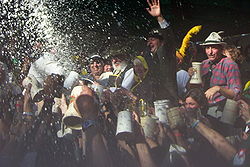
National Beer Festival
Encyclopedia
The National Beer Festival is Argentina
's version of the German
Oktoberfest
. It has taken place every October since 1963. This festival attracts thousands of tourists for two consecutive weekends. Today it is the largest in Latin America after the festival in Blumenau
, Brazil
.
 Villa General Belgrano
Villa General Belgrano
, Córdoba
, founded in 1930, took the characteristics of an Alpine
village with wooden houses, red roofs in two waters, imported central European cuisine and all the habits such as traditional music, dances, parties, crafts and languages from Central Europe
. The party emerged in the village in the 1960s
by the hand of the first German immigrants.
It was traditionally developed in the Plaza Jose Hernandez, but in 1996 moved to a specially designed site, known in Argentina as the Brewer Park (Parque Cervecero in Spanish), with a procession through the streets of the town whith carriages, dance groups, orchestras, villagers in traditional costumes, parades and the special dog sausages
. Each year, the Queen of Oktoberfest Argentina (Reina del Oktoberfest Argentina) is selected in a ceremony held in the same park.
The years passed and the beer industry has been developed considerably. This party grew and began to call for a large number of tourists.
Argentina
Argentina , officially the Argentine Republic , is the second largest country in South America by land area, after Brazil. It is constituted as a federation of 23 provinces and an autonomous city, Buenos Aires...
's version of the German
Germany
Germany , officially the Federal Republic of Germany , is a federal parliamentary republic in Europe. The country consists of 16 states while the capital and largest city is Berlin. Germany covers an area of 357,021 km2 and has a largely temperate seasonal climate...
Oktoberfest
Oktoberfest
Oktoberfest, or Wiesn, is a 16–18 day beer festival held annually in Munich, Bavaria, Germany, running from late September to the first weekend in October. It is one of the most famous events in Germany and is the world's largest fair, with more than 5 million people attending every year. The...
. It has taken place every October since 1963. This festival attracts thousands of tourists for two consecutive weekends. Today it is the largest in Latin America after the festival in Blumenau
Blumenau
Blumenau is a city in Vale do Itajaí, state of Santa Catarina, in southern Brazil. It was founded on September 2, 1850 by Dr. Hermann Bruno Otto Blumenau along with 17 German immigrants. A few years later Fritz Müller migrated to Blumenau as well....
, Brazil
Brazil
Brazil , officially the Federative Republic of Brazil , is the largest country in South America. It is the world's fifth largest country, both by geographical area and by population with over 192 million people...
.
Villa General Belgrano

Villa General Belgrano
Villa General Belgrano, a small mountain village of 6,260 inhabitants is named after the creator of the Argentine flag Manuel Belgrano and located in a lush green valley of Calamuchita in the hills in the Province of Córdoba in central Argentina.-History:...
, Córdoba
Córdoba Province (Argentina)
Córdoba is a province of Argentina, located in the center of the country. Neighboring provinces are : Santiago del Estero, Santa Fe, Buenos Aires, La Pampa, San Luis, La Rioja and Catamarca...
, founded in 1930, took the characteristics of an Alpine
Alps
The Alps is one of the great mountain range systems of Europe, stretching from Austria and Slovenia in the east through Italy, Switzerland, Liechtenstein and Germany to France in the west....
village with wooden houses, red roofs in two waters, imported central European cuisine and all the habits such as traditional music, dances, parties, crafts and languages from Central Europe
Central Europe
Central Europe or alternatively Middle Europe is a region of the European continent lying between the variously defined areas of Eastern and Western Europe...
. The party emerged in the village in the 1960s
1960s
The 1960s was the decade that started on January 1, 1960, and ended on December 31, 1969. It was the seventh decade of the 20th century.The 1960s term also refers to an era more often called The Sixties, denoting the complex of inter-related cultural and political trends across the globe...
by the hand of the first German immigrants.
It was traditionally developed in the Plaza Jose Hernandez, but in 1996 moved to a specially designed site, known in Argentina as the Brewer Park (Parque Cervecero in Spanish), with a procession through the streets of the town whith carriages, dance groups, orchestras, villagers in traditional costumes, parades and the special dog sausages
Dachshund
The dachshund is a short-legged, long-bodied dog breed belonging to the hound family. The standard size dachshund was bred to scent, chase, and flush out badgers and other burrow-dwelling animals, while the miniature dachshund was developed to hunt smaller prey such as rabbits...
. Each year, the Queen of Oktoberfest Argentina (Reina del Oktoberfest Argentina) is selected in a ceremony held in the same park.
The years passed and the beer industry has been developed considerably. This party grew and began to call for a large number of tourists.

